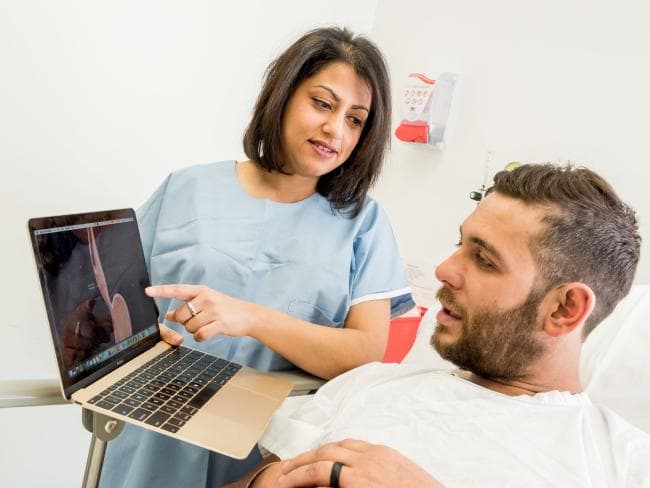Prof Saxena has been performing POEM since 2012. She is internationally renowned and frequently publishes in peer reviewed journals. She serves on an international panel publishing guidelines on the optimal management of achalasia. Prof Saxena is the most experienced POEM operator in Australia. She has performed several 100 procedures and conducts workshops training other gastroenterologists and surgeons both nationally and internationally. She is frequently invited to international conferences to give lectures on POEM and perform the procedure at international endoscopy conferences. She has published numerous articles about POEM.
POEM is a minimally invasive, endoscopic treatment for achalasia and other swallowing disorders which can be performed without any abdominal or chest incisions. Latest studies show POEM has 98% clinical success rates. A recent meta-analysis published by Prof Saxena and international co-authors has also shown POEM is superior to pneumatic dilatation and Heller myotomy for the treatment of achalasia.
POEM surgery takes approximately two hours. You will have a swallow study performed later in the afternoon. You will be admitted overnight to ward bed for rest. You will be commenced on clear fluids and discharged home the following day.
You can slowly resume a normal diet over the rest of week, starting with clear liquids, free fluids, soft food then normal diet by the weekend.
POEM: Why It’s Performed
To treat the following diseases:
• Achalasia
• Diffuse oesophageal spasm
• Nutcracker oesophagus
• Jackhammer oesophagus
• Recurrence of swallowing problems after prior treatment with heller myotomy or pneumatic balloon dilatation
POEM: What to Expect
Prof Saxena will discuss with you in detail during consultation.
· You may only have a liquid diet for one-two days prior to the procedure
· You may not drink for 6 hours prior to your procedure. This ensures that your oesophagus is clear of food products.
During POEM:
We will insert an IV into your vein in order to administer fluids, anesthesia and antibiotics. You will have a general anaesthetic.
Once the procedure is finished, you will need to recover from the anesthesia in the endoscopy unit. Then you will be admitted to a ward bed for monitoring and antibiotics. You will keep fasting on the night of the procedure.
You will receive an X-ray (barium swallow) the following afternoon and you will be permitted to drink liquids if the test comes back OK. You will be discharged with advice to advance to a soft diet and then resume a normal diet by the end of the week.
What is POEM:
This is a 4-step endoscopic procedure. We pass an endoscope through the mouth, create a tunnel in the oesophagus to access the muscle and then cut the muscle. We close the tunnel using endoscopic clips.
What is achalasia
It is a rare disorder. The main symptoms include
· trouble swallowing
· chest pain
· heartburn/reflux
· In children, can be failure to thrive (not growing)
The muscle at the bottom end of the oesophagus is called the lower oesophageal sphincter. The sphincter relaxes to allow passage of food and liquids from the oeosophagus into the stomach. In patients with achalasia, there are very high pressures in the lower oesophageal sphincter. The sphincter is tight and doesn’t relax to allow food/drinks to pass easily.
POEM: How It's Performed
POEM is a minimally invasive, endoscopic treatment for achalasia and other swallowing disorders which can be performed without any abdominal or chest incisions. Latest studies show POEM has 98% clinical success rates. A recent meta-analysis published by Prof Saxena and international co-authors has also shown POEM is superior to pneumatic dilatation and Heller myotomy for the treatment of achalasia.
POEM surgery takes approximately two hours. You will have a swallow study performed later in the afternoon. You will be admitted overnight to ward bed for rest. You will be commenced on clear fluids and discharged home the following day.
You can slowly resume a normal diet over the rest of week, starting with clear liquids, free fluids, soft food then normal diet by the weekend.
POEM: Why It’s Performed
To treat the following diseases:
• Achalasia
• Diffuse oesophageal spasm
• Nutcracker oesophagus
• Jackhammer oesophagus
• Recurrence of swallowing problems after prior treatment with heller myotomy or pneumatic balloon dilatation
POEM: What to Expect
Prof Saxena will discuss with you in detail during consultation.
· You may only have a liquid diet for one-two days prior to the procedure
· You may not drink for 6 hours prior to your procedure. This ensures that your oesophagus is clear of food products.
During POEM:
We will insert an IV into your vein in order to administer fluids, anesthesia and antibiotics. You will have a general anaesthetic.
Once the procedure is finished, you will need to recover from the anesthesia in the endoscopy unit. Then you will be admitted to a ward bed for monitoring and antibiotics. You will keep fasting on the night of the procedure.
You will receive an X-ray (barium swallow) the following afternoon and you will be permitted to drink liquids if the test comes back OK. You will be discharged with advice to advance to a soft diet and then resume a normal diet by the end of the week.
What is POEM:
This is a 4-step endoscopic procedure. We pass an endoscope through the mouth, create a tunnel in the oesophagus to access the muscle and then cut the muscle. We close the tunnel using endoscopic clips.
What is achalasia
It is a rare disorder. The main symptoms include
· trouble swallowing
· chest pain
· heartburn/reflux
· In children, can be failure to thrive (not growing)
The muscle at the bottom end of the oesophagus is called the lower oesophageal sphincter. The sphincter relaxes to allow passage of food and liquids from the oeosophagus into the stomach. In patients with achalasia, there are very high pressures in the lower oesophageal sphincter. The sphincter is tight and doesn’t relax to allow food/drinks to pass easily.
POEM: How It's Performed
Who is eligible for the procedure
Any patient with symptoms and confirmed diagnosis of achalasia or other oesophageal motility disorders. Even if you have had prior therapy with either surgery or endoscopic dilatation, you can still have a POEM.
What are expected outomes
We measure the severity of your symptoms and also the pressures in your oesophagus before your procedure (oesophageal manometry).
The severity symptom score will normalize after your procedure, you will be eating and drinking normally.
What are the benefits:
POEM replicates the surgical procedure of heller myotomy but without any abdominal or chest incisions or scars. There is shorter hospital stay and less post-procedure pain in comparison to surgery.
Patients with type III achalasia or esophageal disorders involving the higher oesophagus are more likely to benefit from POEM rather than surgery

